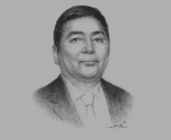OBG talks to Luimed Gansukh, Former Minister of Environment and Tourism

Interview: Luimed Gansukh
Which areas of the industry do you expect to be the primary growth drivers for arrivals in the future?
LUIMED GANSUKH: The National Tourism Policy that the Ministry of Nature, Environment and Tourism (MNET) has proposed identifies six areas for expansion; however the three primary drivers are expected to be ecotourism, border tourism and historical/cultural tourism. Ecotourism, which attracts wealthy Western tourists, is of special interest because it allows Mongolia to highlight its natural environment and generate tourism receipts while minimising environmental and social degradation. The MNET plans to impose restrictions on the number of visitors and operators in zones that have been set aside for ecotourism.
Border tourism is intended to allow Mongolia to attract tourists from the neighbouring countries of China and Russia. In 2010, Mongolia received 193,730 visitors from China and 121,647 visitors from Russia. As a result, visitors from these two countries represented over 56% of total foreign travellers to Mongolia in 2010. Many of these visits were in fact short trips across the border rather than lengthy stays in the Mongolian heartland. The MNET has recently completed feasibility studies on four areas: Khalkh Gol, Zamyin-Uud, Khovd, and Buir Lake. We are now seeking investors with the intent of developing these areas along the lines of traditional tourism destinations in order to make them more attractive to short-term boarder tourists.
The third area in which we expect to see substantial growth is in historical/cultural tourism. Mongolia’s long history, nomadic lifestyle, and traditions of animal husbandry are significant assets when promoting the country abroad. International interest in Mongolia allowed us to successfully attend the International Tourism Bourse (ITB) Convention in Berlin as a cultural partner this year. One of the key projects which we are developing with regard to historical/cultural tourism is called Kharkhorin 13th Century. The project aims to create a large historical theme park, which invokes the power of the Mongolian Empire during the 13th century.
How is the responsibility for developing tourism initiatives and infrastructure divided between the public and private sectors?
GANSUKH: Promoting and developing tourism is primarily the responsibility of the private sector, with the public sector playing a supporting role. In 2000 the Mongolian government established legislation to liberalise the tourism sector and encourage growth.
Furthermore, the MNET supports the private sector in several ways. It provides state funds to subsidise Mongolian companies that attend international tourism conventions. The MNET is in charge of managing the national tourism website and is developing a database of all tour operators, accommodation providers and tourism oriented non-governmental organisations in the country. The ministry also oversees the creation of policy papers for the sector.
In the near future, however, this situation is expected to change. A national tourism policy currently before the legislature will emphasise the role that regional governments play in the tourism sector, and is focused on dividing the country into six zones: ecotourism, culture/historical, urban, border area, adventure tourism and special interest (hunting, agrotourism, medical). Regional governments will be expected to map their territory into different zones, which Mongolia intends to develop through public-private partnerships.
What steps are being taken to reduce the seasonality of the tourism industry in Mongolia and transform the country into a year-round destination?
GANSUKH: The seasonality of the sector is significant. Currently, 80% of our visitors come during the summer months. In order to reduce seasonality, the MNET has highlighted almost 30 major events each year. Most of these occur outside of the high-season in order to encourage increased tourist flows at other times of the year. Some of the key events include the Eagle Festival in early October and March, a Lunar New Year’s event, as well as the Ice and Camel Festivals in March.
You have reached the limit of premium articles you can view for free.
Choose from the options below to purchase print or digital editions of our Reports. You can also purchase a website subscription giving you unlimited access to all of our Reports online for 12 months.
If you have already purchased this Report or have a website subscription, please login to continue.

